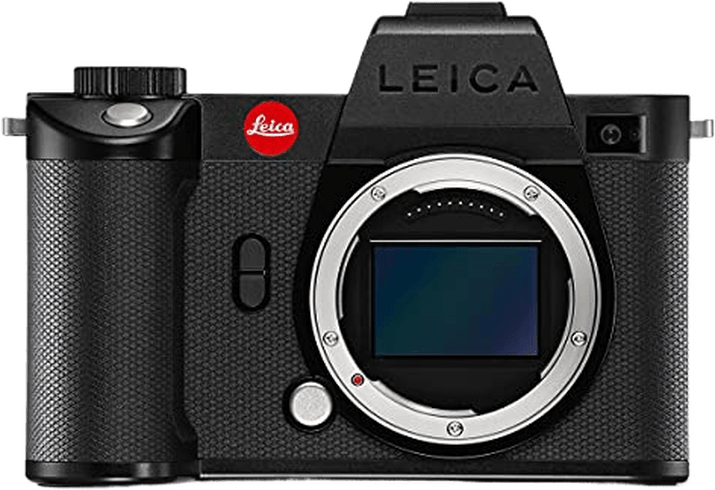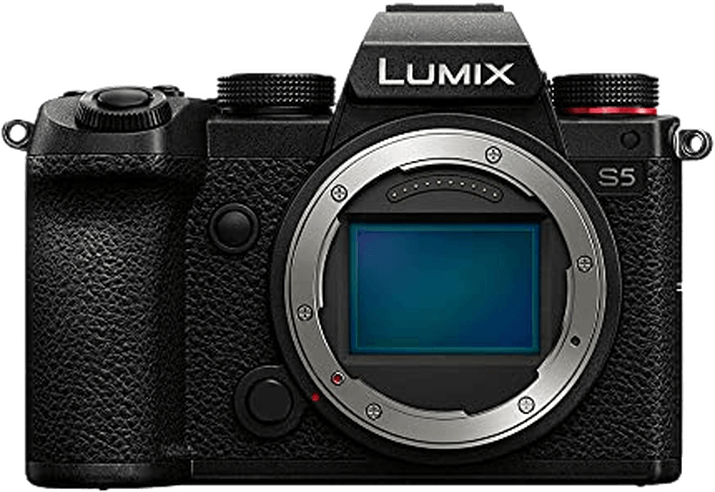Leica SL2-S vs Panasonic Lumix DC-S5 Comparison
Leica SL2-S

Panasonic Lumix DC-S5

The Leica SL2-S outperforms the Panasonic Lumix DC-S5 with a score of 81/100, while the Lumix DC-S5 stands close with 79/100. Both cameras are mirrorless, announced in 2020 and 2021, respectively. They share some key specifications, including camera type and a similar size. The Leica SL2-S is larger, measuring 146 x 107 x 83mm, while the Panasonic Lumix DC-S5 is 133 x 97 x 82mm.
The Leica SL2-S excels with its higher score, but it comes at a higher launch price of $4895 compared to the Panasonic Lumix DC-S5’s $1999. The SL2-S is also heavier, weighing 931g (2.05lbs), while the Lumix DC-S5 is lighter at 714g (1.57lbs).
Despite the higher score and better performance, the Leica SL2-S’s higher price and weight may not be suitable for everyone. The Panasonic Lumix DC-S5 offers a more budget-friendly and lightweight option with only a slight difference in performance. Ultimately, the choice between these two cameras depends on the user’s priorities and budget.
Leica SL2-S vs Panasonic Lumix DC-S5 Overview and Optics
The Leica SL2-S outperforms the Panasonic Lumix DC-S5 in optics with a score of 85/100 versus 78/100. Both cameras share several specifications, including a CMOS sensor, full-frame sensor size, Leica L lens mount, and image stabilization.
The Leica SL2-S excels with its higher megapixel count of 24.6 compared to the Panasonic Lumix DC-S5’s 24.2. This difference allows for slightly better image resolution. The shooting speed of the Leica SL2-S is significantly faster at 20 frames per second, compared to the Panasonic Lumix DC-S5’s 7 frames per second. This higher speed enables the user to capture fast-moving subjects more effectively. The Leica SL2-S also boasts a superior processor, the Maestro III, and a marginally better DXOMARK sensor score of 95, compared to the Panasonic Lumix DC-S5’s Venus Engine and DXOMARK score of 94.
On the other hand, the Panasonic Lumix DC-S5 does not have any specific advantages in optics over the Leica SL2-S. The two cameras share many features, but the Panasonic Lumix DC-S5 falls short in the areas where the Leica SL2-S excels, such as megapixel count, shooting speed, and sensor score.
The Leica SL2-S emerges as the superior camera in terms of optics due to its higher score, which results from its better specifications like the higher megapixel count, faster shooting speed, and better processor. The Panasonic Lumix DC-S5, while sharing many features with the Leica SL2-S, does not offer any unique advantages in the optics department. Therefore, for those prioritizing optical performance, the Leica SL2-S is the better choice.
Leica SL2-S vs Panasonic Lumix DC-S5 Video Performance
The Leica SL2-S and the Panasonic Lumix DC-S5 both have a video score of 83/100, indicating that they are equally capable in terms of video performance. Both cameras share several key video specifications, such as 4K video resolution, 60fps maximum video frame rate, and built-in time-lapse functionality.
Despite having the same video score, the Leica SL2-S has a slightly higher maximum video dimension of 4096 x 2160 compared to the Panasonic Lumix DC-S5, which has a maximum video dimension of 3840 x 2160. This difference in dimensions gives the Leica SL2-S an advantage in terms of video quality, as it can capture more detail in each frame.
On the other hand, the Panasonic Lumix DC-S5 may have some benefits over the Leica SL2-S in other areas, such as additional video features or a more user-friendly interface. However, based on the specifications provided, there is no clear advantage for the Panasonic Lumix DC-S5 in terms of video capabilities.
In comparing the video capabilities of the Leica SL2-S and the Panasonic Lumix DC-S5, it is evident that both cameras are highly capable, with the Leica SL2-S having a slight edge in video dimensions. This difference may not be significant for all users, but for those seeking the highest possible video quality, the Leica SL2-S is the better choice. Meanwhile, the Panasonic Lumix DC-S5 remains a strong contender, offering similar video capabilities at a potentially more affordable price point or with additional features not mentioned in the specifications.
Leica SL2-S vs Panasonic Lumix DC-S5 Features and Benefits
The Panasonic Lumix DC-S5 wins in the features comparison with a score of 85/100, while the Leica SL2-S scores 74/100. Both cameras share some common specifications, including a touchscreen, WIFI, and Bluetooth connectivity. Neither camera has GPS.
The Lumix DC-S5 has a 3-inch screen, which is smaller than the SL2-S’s 3.2-inch screen. However, the S5’s screen has a flip feature, making it more versatile for different shooting angles. The Leica SL2-S does not have a flip screen. Despite having a larger screen, the SL2-S has a higher screen resolution of 2,100,000 dots, compared to the S5’s 1,840,000 dots.
The Lumix DC-S5’s higher feature score can be attributed to its flip screen, which makes it more convenient for various shooting situations. This advantage makes it a better choice for photographers who require flexibility in their compositions.
On the other hand, the Leica SL2-S’s larger screen and higher resolution provide a better and more detailed viewing experience. This advantage may be preferred by photographers who prioritize image quality and detail when reviewing their shots.
In comparing the two cameras, the Panasonic Lumix DC-S5’s flip screen feature stands out as a significant advantage for versatile shooting. The Leica SL2-S’s larger screen and higher resolution provide a better viewing experience, but its lack of a flip screen limits its flexibility. The Lumix DC-S5 is the better choice for photographers who prioritize versatility, while the SL2-S may be more suitable for those who value image quality and detail.
Leica SL2-S vs Panasonic Lumix DC-S5 Storage and Battery
The Leica SL2-S triumphs over the Panasonic Lumix DC-S5 in storage and battery with a score of 73/100 compared to the latter’s 71/100. Both cameras share similarities, such as having two memory card slots and accepting SD, SDHC, and SDXC memory cards. They also both offer USB charging capabilities, making them convenient for on-the-go users.
The Leica SL2-S outperforms the Panasonic Lumix DC-S5 in battery life, providing 510 shots before needing a recharge, while the Lumix DC-S5 can only manage 440 shots. This advantage makes the SL2-S more suitable for extended shooting sessions without needing to replace the battery.
However, the Panasonic Lumix DC-S5 has a minor edge in memory card compatibility, as it supports UHS-II cards, allowing for faster data transfer rates. This feature could be beneficial to photographers who require quick file transfers for their workflow.
Ultimately, the Leica SL2-S proves to be the superior option in terms of storage and battery life, making it an ideal choice for photographers who prioritize longevity in their shooting sessions. The Panasonic Lumix DC-S5, on the other hand, may still appeal to those who value faster memory card performance.
Leica SL2-S vs Panasonic Lumix DC-S5 Alternatives
Still not sure which camera to choose? Try these popular camera comparisons for more inspiration:
